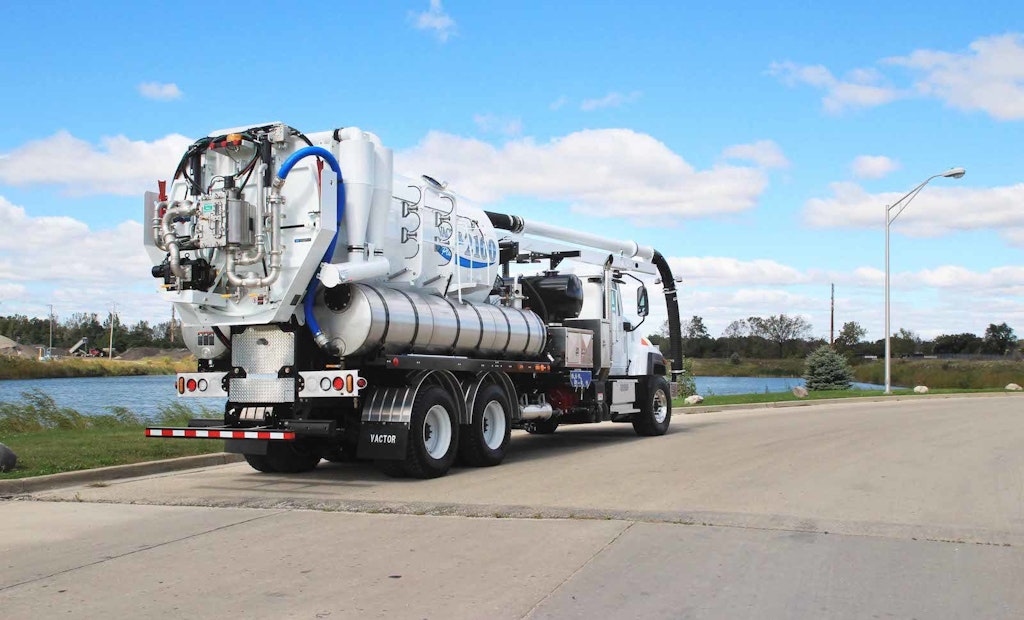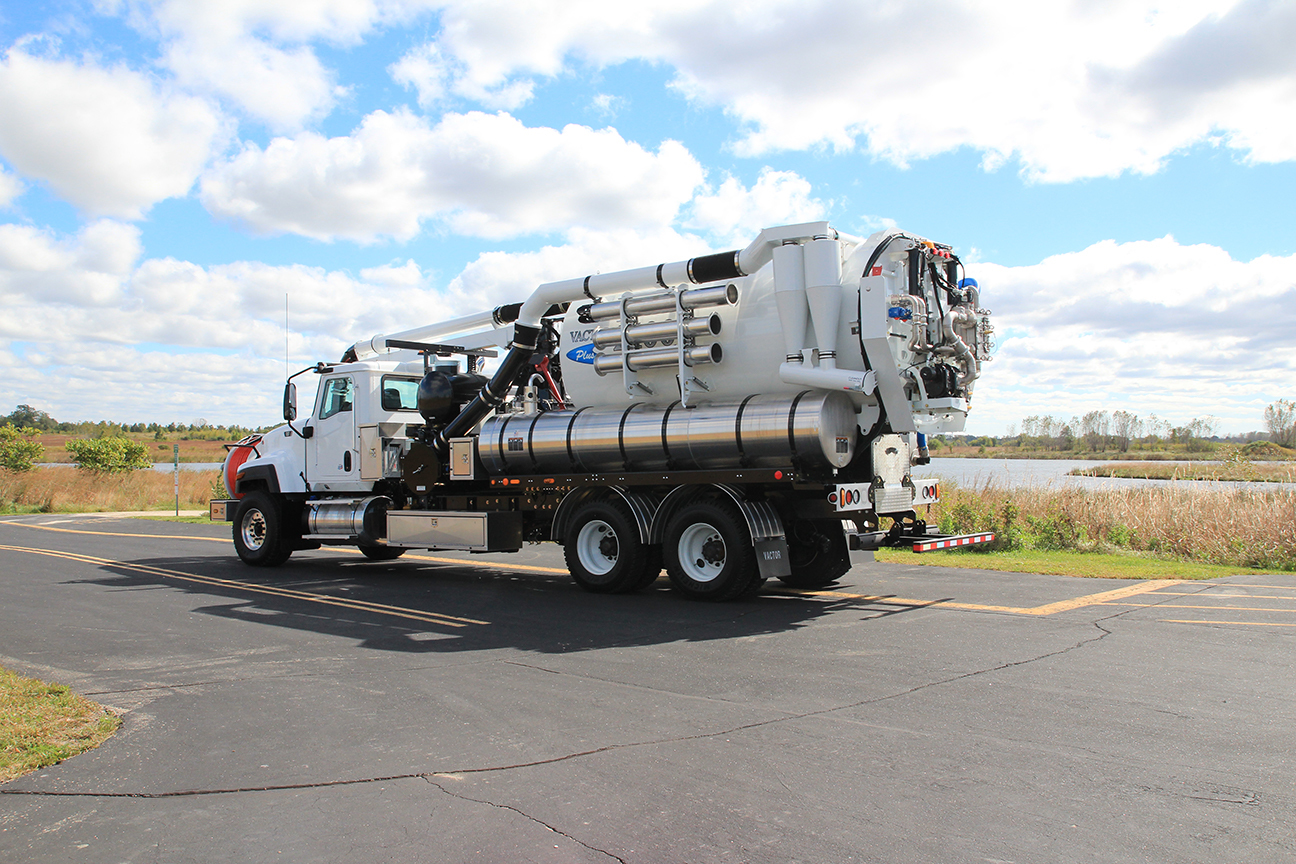Interested in Trucks?
Get Trucks articles, news and videos right in your inbox! Sign up now.
Trucks + Get AlertsContractors, municipalities and utility companies can all realize great benefits using a combination sewer cleaner equipped with a water recycling system. You are all facing many of the same challenges: reducing the impact on the environment, conserving resources, advancing the productivity of the line-cleaning process, and cleaning more sewer line with the resources you have. A water recycling system provides a substantial step in the right direction.
Benefits of a water recycling system
A combination sewer cleaner equipped with a water recycling system offers a number of benefits, including:
Promoting sustainability, reducing or eliminating the use of clean water
Communities have a duty to conserve and protect resources, and it makes very little sense to use potable water for cleaning a sewer. Vactor’s system conserves a precious resource while offering tremendous productivity gains and savings.
Water is becoming more valuable
It’s not unusual for a typical combination sewer cleaner to use around 10,000 gallons of clean freshwater each day. Eliminating that usage is a huge gain for the environment.
Many communities have needs to conserve water. Many communities are restricting where trucks can be refilled, which further reduces productivity, because refilling is required multiple times a day and this process is all wasted time, fuel and risk, and results in added wear and tear on the vehicle. With a water recycling system, the use of potable water for line cleaning can be eliminated. A water recycling system not only reduces the cost of using freshwater, it also reduces the time required to make multiple trips to a hydrant or water filling facility to refill the truck.
Reduced overflows
Communities are expected to maintain their sewer systems and prevent overflows to protect people and the environment, and to avoid the potential for financial penalties and health risks associated with overflows. In addition, many communities are working with reduced budgets for operating expenses. With the ability to recycle the water used for sewer cleaning, these communities can clean more lines with existing resources and reduce operating costs.
Hiring and finding personnel is becoming increasingly more difficult
There is less need for labor to assist with the line-cleaning operation, which is a pure cost savings, particularly when working out of town, which brings the added costs of temporary workers or travel expenses.
Without the need to stop work to replenish the clean water supply, sewer cleaning operations will experience higher onsite performance. In many cases, contractors are paid by the feet of sewer line cleaned. With a water recycling system, productivity is significantly increased, which means operators can clean more lines. There is no need to break down equipment on the job in order to drive to an available hydrant to refill the water tank, a process that normally happens multiple times in a given work day.
Improved safety
During sewer-cleaning operations on busy streets and intersections, police cars, police personnel, flagmen and traffic safety barriers are often required to control traffic around the work area to ensure safe and adequate pedestrian and vehicle access. Without the need to constantly set up and tear down equipment at the job site to refill the truck’s water tank, traffic control is more efficient, and the risks of accidents and related injuries are greatly reduced.
Conserving resources
The demand for water recycling is driven by a general need to conserve resources, clean more lines to prevent overflows, and reduce operating costs. Technology improvements have made water recycling an answer to these needs in sewer-cleaning operations.
Everyone wants to do their part to conserve water to protect the environment. This may be more critical in areas where water is scarce, such as drought-stricken areas, but the need to be more environmentally responsible is universal. Even in areas with an abundance of freshwater, customers are demanding this technology to conserve those resources while advancing their performance.
Water recycling systems help sewer cleaning operations save hundreds of thousands of gallons of fresh, clean water, improve operating efficiencies, reduce costs and promote sustainability. These systems deliver uninterrupted cleaning, enabling sewer-cleaning professionals to clean more storm and sanitary lines in less time, without stopping to refill the water tanks with clean water.
Cost savings
The savings derived from water recycling varies by application and depends heavily on the user’s goals. For example, the value of saving thousands of gallons of clean water per day will vary depending on whether the user has water or not, or whether there are higher priority uses for the clean water they have.
If the goal is to clean more lines and prevent overflows into buildings and waterways, then the cost of avoidance should be considered. The fines, cleanup costs, economic impact and risks to public health associated with overflows are well documented and too often experienced by communities.
Another cost savings is related to access to water, assuming it is available. In many cases, access to water is limited to specific hydrants or locations. In these cases, the sewer cleaner either travels long distances — reducing the available cleaning time — or additional vehicles and personnel are acquired and deployed to transport and transfer water to the unit. In many cases, the refilling of the truck is required every 20 to 30 minutes, which interrupts the cleaning and results in significant operating costs for both the personnel and equipment throughout the day.
There are also indirect costs for traffic control and avoiding the risks associated with operating and moving vehicles on the job site. If the water recycling system is allowed to stay on the job site, these costs and risks can be dramatically reduced.
In general, the return on investment of a sewer cleaner equipped with a water recycling system — the potential to double line cleaning productivity while conserving thousands of gallons of clean water each day — is very attractive when compared to existing alternatives.
More than 30 years of water recycling
Vactor Manufacturing isn't new to water recycling; the company patented and introduced its first recycling system in the early 1980s. Vactor’s latest and most innovative water recycling system is available as an option on the Vactor 2100i combination sewer cleaner.
The system reuses water in the sewer to clean sewer lines, offering the potential to eliminate the need for clean water and saving thousands of gallons of clean water during every shift. Vactor’s five-stage filtration process is simple to operate, easy to maintain, and extremely efficient. The Vactor system delivers uninterrupted sewer line cleaning, enabling operators to clean more sanitary or storm sewer lines in less time, without stopping to refill the water tanks with clean water.
For more information on the Vactor water recycling system available as an option on the Vactor 2100i combination sewer cleaner, check out the video below. To schedule a demonstration, please visit www.vactor.com or see your local Vactor dealer.






